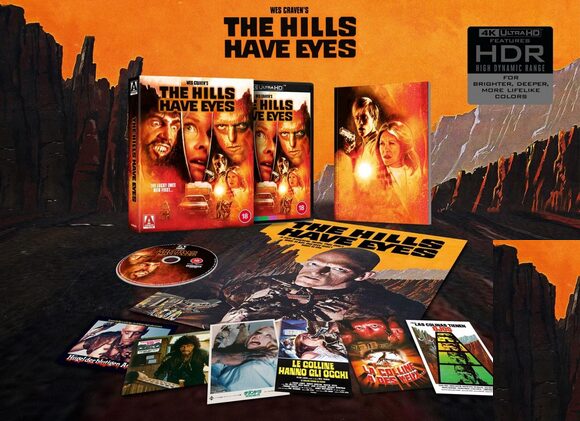
Sounding like a lame retread of The Texas Chainsaw Massacre (1974; dir. Tobe Hooper), The Hills Have Eyes (1977; dir. Wes Craven) is better than that. It’s intriguing yet… underwhelming.
Vacationing to a silver mine in the California desert, a clean yet quarrelsome family of WASPs takes a shortcut that a gas station owner tells them to avoid. Horrible move: their car breaks down, and they become easy pickings for a psycho tribe of incestuous cannibals.
The savages have odd names — Mercury, Pluto, Papa Jupiter. In this sun-blasted hellhole (Craven shot the film in Apple Valley, California), they’ve made their home sweet home among the snakes and crags. Born deformed on account of the nuclear testing in the desert, Papa Jupiter has had a hermetic life; but he’s endured, mating with a prostitute and enjoining his family to raid a disused military base for weapons and CB radios.
After the cannibals attack—stealing the WASPs’ food, even kidnapping a baby, which they plan to eat—their conscientious daughter breaks with them. With her help, the WASPs try to escape. To do so, they must tap into their inner savages. Who will come the victor? Watch and find out.
Inspired by Chainsaw and the legend of Sawney Bean (a 16th-century Scot who ruled a clan of cannibals), Craven mines territory explored in his debut film, The Last House on the Left. There, a respectable, clean-cut family became the target of hippie-ish home invaders. Hills transfers the generational divide of Last House to an urban v. rural schism. As with Last House, Hills pits two disparate groups against each other. Its thesis is plain: When faced with an awful clutch of circumstances, even the most civilized of us can (and just may) become animalistic to survive.
This is a solid enough premise, I suppose; and, infused with the grimy, exploitative edge Craven brought to Last House, it packs a bit of a punch. Yet it’s hard to enjoy, or find scary, his cerebral approach to the material.
Among its assets are Apple Valley, whose stark, jagged terrain lifts it to major-character status. With only sporadic displays of gore (most memorably, the ankle-maiming of a cannibal, the Joshua Tree crucifixion of the racist WASP patriarch, and the use of his wife as bait for the cannibals), the film’s relative restraint of on-screen carnage is something I respect. I also credit Craven for casting Michael Berryman as a cannibal. Berryman was born with hydrotic-extodermaldysplasia; his face can’t help but add a Fellini-esque touch. And, barring a scene of WASP resourcefulness (it’s hard to miss), Craven doesn’t flinch from letting this clan-war conclude the way it should.
Still, we don’t care for the characters. Beast, one of two dogs the WASPs own, is the only ‘animal’ we like. The WASP womenfolk are shrill, hysterical softies. The extent to which this family announces its presence and sticks its collective nose where it shouldn’t (or withholds valuable information from each other until it’s too late) is dumb. Craven doesn’t develop them into people with lives, minds, and whims of their own. They’re not believable. We can’t relate to them (at least not any more than we can the baddies). Until the WASPs left standing out-think the cannibals (a feat the heroes were before too shell-shocked to even conceive of), they’re loud and stupid targets. Had Craven given them, and treated them with, more intelligence—had the cannibals remained a darker, less explained, and less humanized device—Hills might have been a frightening experience.
The movie also takes forever to get cranking. I don’t mind a slow buildup of tension. Craven, though, wastes the opportunity. As a then-novice storyteller, he doesn’t give us characters we can root for, and (lacking Hooper’s artistic eye) he fails to create a mounting sense of dread. Once the cannibals launch their nightly attack, he hasn’t earned our good will. We just wait (and wait) for a cheap thrill, for something bloody to happen.
For all these reasons, Hills can’t overcome its basis in exploitation. It ends up a crude, emotionally flat exercise in watching these two families converge. An interesting, but ineffective, entry in the ‘hellbilly’ subgenre.
Craven got better. Six years later, he directed A Nightmare on Elm Street. Its command of technique, and the inventive way it plays with slasher movie tropes, elevates it far past the films he made in the ‘70s. With a slick, self-referential sense of irony, Scream (1996) was a highwater mark for him. The Hills Have Eyes shows little promise of the glories to come. Had it seduced us with fear, it’d have more than just a cult audience.
The new Arrow Video 4K UHD restoration is a thing of beauty. The restored 16mm print still looks grainy, especially during the night scenes; but features are a-plenty: postcards; a reversible foldout poster; a limited-edition booklet; three different audio commentaries (one has Berryman, another has Craven); a making-of documentary; outtakes; an alternate ending; trailers and TV spots; an image gallery; and the original screenplay. If you love this film, the Arrow package is an absolute must.